How to Transfer Xbox One to Xbox One S
Even if you don't know the design consultancy Teague, you know its work–ranging from the original Polaroid camera to the interiors of almost every Boeing plane to date. It was also the firm Microsoft tapped to design the original Xbox, conceptualize controllers for the Xbox brand, and create the Xbox 360 racing wheel. Imagine our delight when designers at Teague volunteered to apply their expertise in a critique of the Xbox's latest and greatest competitor, the PlayStation 4–and then turn their sights to Microsoft's latest creation (for which they offered no consultancy), the Xbox One. –Eds.
Everyone loves the underdog. This age-old archetype has universal appeal whether it's Goliath's David, Frodo Baggins, or Rocky Balboa. As Microsoft released its third console, the Xbox One last week–which was designed in-house and which sold a million units faster than any of its previous releases–it's easy to forget that the gaming system was once an underdog in this space, too. The Xbox One is Microsoft's best designed gaming system to date, a clear (if imperfect) attempt at refining all the details and making disparate parts feel whole. Whether it'll be Xbox's greatest legacy is another matter.
Xbox's David to Sony's Goliath
Coming from a parent company with more experience in Microsoft Office productivity than film and gaming entertainment, the original Xbox console entered the gaming ring as the long shot, nearly 20 years after the birth of Super Mario Brothers.
Microsoft's first combatant in a world dominated by Nintendo's casual gaming and Sony's more mature polygons was a big bruiser of a box, with a controller twice the size of the competition; bold and brash, the Xbox turned heads, for good or bad.
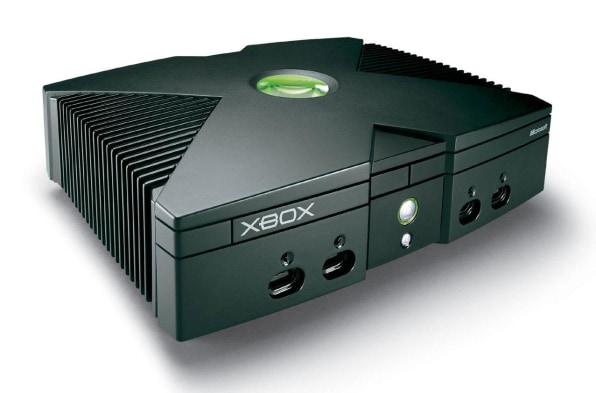
Leaning on its software expertise to deliver a superior online experience, in 2005, Microsoft released its second console, the Xbox 360. If the original Xbox looked like it was bursting at the seams, the Xbox 360–designed by an external firm–had a concave front that made it look like it was sunken in. The Xbox 360 was also released with an impressive head start on the competition as Sony's PS3 and eventual top-selling Nintendo's Wii both launched in 2006. The 360 made massive strides, gaining significant market share and going toe-to-toe with Nintendo and Sony.
Nintendo's next console, the Wii U launched with little fanfare, and many speculate Nintendo's ability to compete in hardware into the future. Now, with the release of Sony's PS4 and Microsoft's Xbox One this month, two tech heavyweights enter the ring again, quite possibly for the last time before video game consoles as we know them–elaborate boxes fit with cutting-edge graphics and processors–disappear into the cloud. Does either console have what it takes to snatch the world champion title in its own right?
As with our previous critique of PlayStation 4, this review will focus solely on the industrial design of the Xbox One console and controller with the aim of providing a designer's perspective on the choices that were made, and the likely reasons behind them.
Greater than the sum of its parts.
Thirteen years have passed since the original Xbox's debut and the Xbox One for its part hasn't lost much weight; its footprint is actually larger. Luckily its cleaner lines and slimming, simple black accents save it from looking bigger. It's clear from the console's size as well as the number of vents (more on that later) there were some serious technical challenges to overcome this time around. The Xbox 360 ran incredibly hot due in part to its compact size relative to its chipset (which didn't allow for easy dissipation of heat); a design mistake that cost Microsoft $1 billion in the "Red Ring of Death" recalls. Beyond that, there's a correlation between size and noise to consider. The larger a box, the larger its fans can be. The larger the fan, the quieter it can run. So while the Xbox One is large, it would paradoxically have been louder if it were smaller.
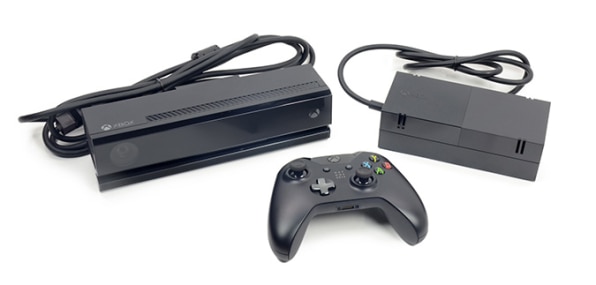
Adding to the bulk, the Xbox 360's old friend, the bulky external power brick, is unfortunately back. There may be a few reasons for this. The first is, again, heat dissipation. The second is that, as Microsoft ships Xbox Ones around the globe, this component could be inexpensively swapped out for regional electrical standards. Any way you cut it, it's true the Xbox One's size isn't ideal. And the fact that Sony fit a power brick within the smaller PS4 may demonstrate the company's existing expertise next to Microsoft, the traditional software maker. But for us, size isn't a deal breaker.
Besides, Microsoft's brick comes an interesting design consideration. It has a 50/50 divide of matte and gloss, along with the same white power light you see on the console. These touches may seem subtle, but they make a big statement: The Xbox One's design language has impacted everything, and we mean everything–even a big old power brick that may sit in the dark dust behind your entertainment center.
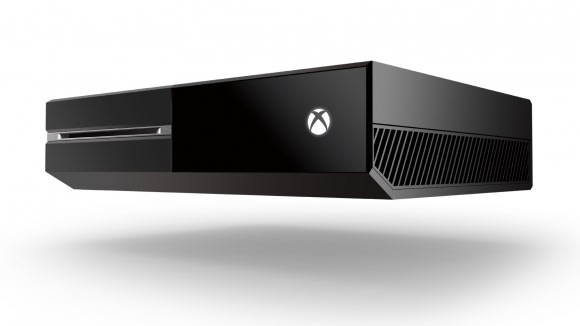
As for that design language itself, gone are the Xbox 360's flamboyant and energetic bloated/deflated profiles, directional detailing, and optional vertical orientation (Eds: you could stand the Xbox 360 up if you wanted) that aimed to make the console look like a gaming machine. The Xbox One now embraces the quiet qualities of more traditional cable or satellite boxes, and that's no accident. A nod to its intended role as the center of entertainment, the front-facing surfaces are kept clean and functional; they contain the most visually rich features divided into two distinct zones. The left side is all business, with a matte finish panel bisected via a chiseled chrome strip that houses the drive slot, the eject button (and around the corner, the sync button). The right side on the other hand, is all about magic. The new chrome Xbox logo is magically suspended in a simulated glass face. When turned on, the seemingly opaque logo jewel becomes softly backlit, creating a subtle gradient from the center to give this essentially flat feature a beautiful 3-D spherical appearance.
Things become a bit less magical once you move around the box–it's dominated on all sides (including the top) by a massive amount of louvered venting. This heavy breathing machine very clearly requires some serious ventilation–a fact that undoubtedly influenced the overall aesthetic.
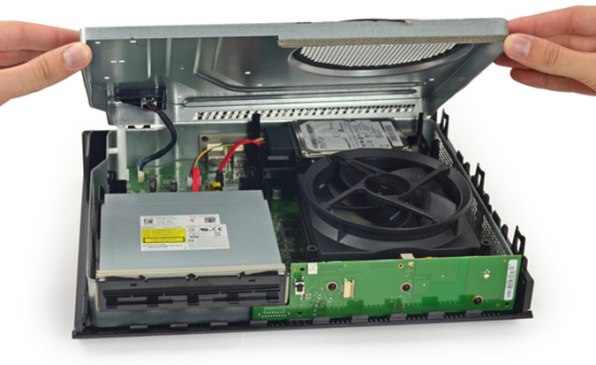
The new Kinect camera shares the Xbox One's design language and its front facing philosophy. Gone is the playful WALL-E like head, replaced by the One's flat simulated glass panel and backlit logo. A single detailed camera lens now visibly sits behind the "glass," while the depth camera lenses are concealed from sight. Below the cameras, floats a somewhat over detailed micromesh microphone bar.
Collectively everything works well–even if at times, it feels a little over-detailed–with an impressively consistent design language across the system. The Xbox One presents itself as a serious, but reserved, high-end component system box.
If it ain't broke, don't fix it.
The Xbox controller has a somewhat sordid history. The Xbox console originally launched with the "Duke," a massive and polarizing game controller that strongly reinforced Xbox's intention to out-adult its rivals. The Duke had a hardcore fan base, but its size alienated a younger demographic Xbox had hoped to win over. Xbox later released the shrunken "S-controller" as a better fit for the small hands of younger gamers. But there was still room for improvement.
Those improvements came in the shape of the Xbox 360 wireless controller. Combining all of the unique Xbox elements (trigger keys, centered Xbox logo, and asymmetric joysticks) with a built-from-the-ground-up ergonomically centered, yet visually clean body, Xbox had a gaming knockout.

We are happy to see that new Xbox One controller is an elegantly evolved version of our 360 favorite. Following a reported $100 million in research, it seems Microsoft didn't want to mess with a good thing and instead made some key choices to elevate this icon. Fit and finish is much improved. Using both gloss and matte black finishes and cleaner lines, it delivers a sophisticated look that aligns with the new console.
The further refined shape excludes any external fasteners (screws) using a snap fit construction. The part lines are tighter and placed in an area where less dead skin will get trapped (ew!), and these splits have been rounded over so they feel more like seams than biting edges. This approach also follows the design philosophies of other high-end companies. Apple regularly hides fasteners to simplify the appearance and the feel of their devices. After all, the point is to present a holistic device that supports an experience, not a gathering of parts that function as required.
Form-wise, the new triggers feel very similar (aside from the awesome addition of haptic rumble that can vibrate the trigger as an onscreen engine roars or a gun fires), but aesthetically they've been sculpted into a continuous form that flows across the front of the controller, unifying all the disparate parts into one cohesive statement.
The d-pad has also been shown some love taking the shape of a cleaner more appropriate retro icon. The joysticks are slightly smaller, with the conical center that honors the previous console while providing a precise feeling rest point for the thumbs. The edge knurling around the joysticks not only provides superior grip, but also give it a look that reminded some of us of dial calipers one might find in a mechanic's tool chest.
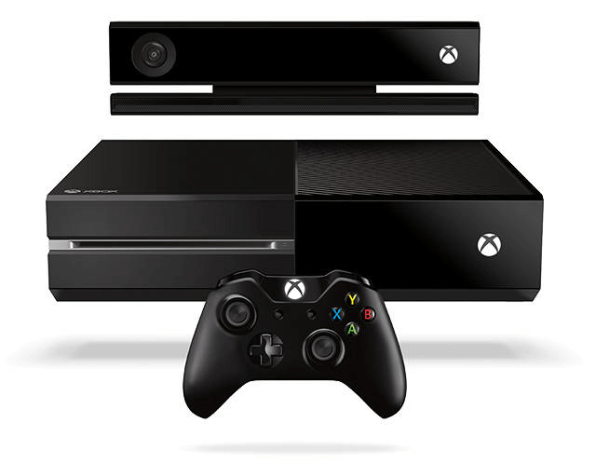
The finishing touch for us is the placement of the Xbox One logo jewel, now housed in the black gloss with the same magical glow that the console and Kinect share. We do miss the player number markers that used to surround the Xbox jewel on the 360–an elegant green ring that would designate whether you were player one, two, three, or four–but we'll get over it as the Kinect promises to fill in that responsibility automatically. It can see an IR signal sent out by each controller, plus it can make out the different people in a room. Thereby, it can keep track of which player is holding which controller by sight.
Hands down, this is the best Xbox controller to date. Given the chance to create something completely new, one has to work extremely hard to resist the temptation. Fortunately Microsoft chose to stick with what worked, to evolve the new controller only so far as it improved the gaming experience for the user and aesthetically brought it closer to the console design.
It's the little things.
Since the debut of the original Xbox, Microsoft's gaming systems have done a nice job with design cohesiveness, but the Xbox One takes it to a new level. There's not a single piece in the Xbox One packaging that hasn't been considered and aligned to the new design direction. Everything from the headset, which, for an inexpensive pack-in, has some nice details, to the HDMI cables, which could have easily been off-the-shelf items, has been given the same matte/gloss box aesthetic–and that takes a lot of time and effort. For us, the attention to detail and the example of how all components can adhere to a single design language despite their functional differences, make this the best-designed Xbox to date. But only time will tell if the One is capable of winning over the hearts and minds of its audience, or if it will just be seen as "the big gaming console."
Read Teague's review of the PS4 here.
Read Co.Design's take on the PS4 here and Xbox One here.
How to Transfer Xbox One to Xbox One S
Source: https://www.fastcompany.com/3022186/the-design-studio-behind-the-original-xbox-reviews-the-xbox-one

0 Response to "How to Transfer Xbox One to Xbox One S"
Post a Comment